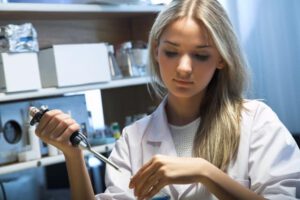 There are two main types of uterine cancer:
There are two main types of uterine cancer:
- Endometrial cancer – which forms in the endometrium, a mucus membrane inside the uterus
- Uterine sarcoma – which forms in the uterine muscles and supporting tissue
The chances of developing uterine cancer are around 1.5%. The average age of women diagnosed is 61 years. Most patients (85%) are diagnosed during early stages of the disease – stages 1 or 2.
Accordingly, this disease has a favorable prognosis. Bleeding after menopause is one of the first symptoms that leads patients to undergo screening tests that produce to a diagnosis.
Risk factors include obesity, diabetes, using the drug Tamoxifen, undergoing hormone replacement therapy (estrogen), and more. A disorder known as HNPCC is also a risk factor.
What is HNPCC?
HNPCC (hereditary nonpolyposis colorectal cancer, also known as Lynch syndrome) is a disorder that accounts for most hereditary endometrial cancer cases. It was once believed that this syndrome is only linked to colon cancer, but it has been proven to also be linked to other types.
Lynch syndrome is caused by a defect in one of the genes responsible for coding protein that affect DNA mismatch repair. Several gene mutations are known to cause this disorder. The most common are MLH1 and MSH2.
Mutations in one or more of these genes increase the risk for developing endometrial cancer by 42-60%.
Similarly, carriers of these gene mutations are at an increased risk (70-82%) for developing colon cancer (the risk in general population is only 2%).
Who is the test recommended to?
Screening tests are not offered to general population and are recommended according to certain criteria, known as the Amsterdam criteria and Bethesda system.
The Amsterdam criteria are strict and are considered outdated, since they were developed in 1991 before it became known that the disorder increases the risk for other types of cancer besides colorectal cancer. Accordingly, changes to these criteria were implemented in 1998 (known as the Amsterdam-plus model).
These criteria are used to diagnose families that are definite carriers of the gene mutation, whereas the Bethesda system is used to diagnose families that could make the most out of genetic screening for this disorder.
How is the test performed?
Women at risk for this disease can undergo genetic screening tests. These tests include three main stages:
Microsatellite instability status analysis: one of the main characteristics of tumors in Lynch syndrome is microsatellite instability (also known as MSI). For this reason, the first stage of screening is a comparison of genetic material in a cancer tissue sample to a healthy tissue sample. MSI occurs in around 90% of tumors in HNPCC patients. However, MSI alone is insufficient for a definite diagnosis.
IHC testing: if microsatellite instability is indeed detected during the first stage of screening, the next stage includes immunohistochemistry testing (also known as IHC), which tests for several types of protein in the tumor tissue. By analyzing the types of protein that are not present in the sample, the affected genes can be determined.
Detecting the gene mutation: if IHC screening indicates that the tumor has developed due to Lynch syndrome, the next stage is determining the genetic sequencing for the genes MSH2 and MLH1.
What are the stages after detecting a gene mutation?
After the relevant gene mutation has been detected, other family members can also undergo screening procedures to test whether they too have this disorder.
Having Lynch syndrome has profound implications on various types of cancer. Concerning uterine cancer, getting a diagnosis for Lynch syndrome usually implies frequent follow-up that monitors for the disease’s first symptoms.
Among these procedures is a transvaginal ultrasound. In addition, important steps include monitoring CA-125 levels and undergoing an endometrial biopsy every 1 – 2 years starting at age 30, and annually from age forty and above.

